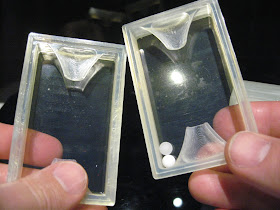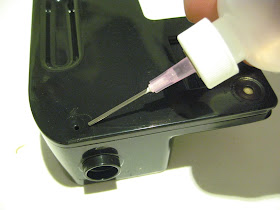Inspired by a wasp trap, a friend suggested a water-filled dexterity puzzle that challenges the user to guide a floating ball into an inverted funnel. It's a cool idea, but why not use two balls: one that floats and another that sinks. I designed a two-piece box that had transparent windows and two funnel-shaped goals.
I put two little balls inside and sealed it full of water. One ball is polypropylene, which floats, while the other is made of PTFE, which sinks. The challenge is to get the floating ball into the funnel at the top and the sinking ball into the funnel at the bottom--at the same time! My first test model seemed to work perfectly.
Problem! The PVC windows gradually fogged up as the PVC absorbed moisure. After a couple of days it turned completely opaque. This effect is reversible: it turns transparent again if it dries out, but the puzzle needs to be filled with water so this design just wasn't practical.
So I tried a different approach: I incorporated the funnels into two caps that could be bonded to a piece of acrylic tubing. Acrylic doesn't absorb moisture so it would stay crystal clear, right? I assembled a test model and filled it through a fine needle and sealed it up.
This worked much better: the side walls were perfectly clear and the cylindrical shape worked like a lens. Here's how it looks when solved, with the floating ball in the funnel at top (barely visible) and the sinking ball in the bottom funnel. At first it seemed perfect: no fogging, no bubbles!
But a small bubble appeared a few days later, and gradually grew. After two months it had grown so large that it interfered with the balls, and it's obviously going to keep growing. So this won't work, either.
Although the containers seem to be watertight--no leaks--I'm guessing the PVC isn't vaportight. So the water vapor could be escaping by diffusion through the PVC end caps. But my coworkers liked this puzzle while it worked, so it's worth another try. Back to the drawing board!










